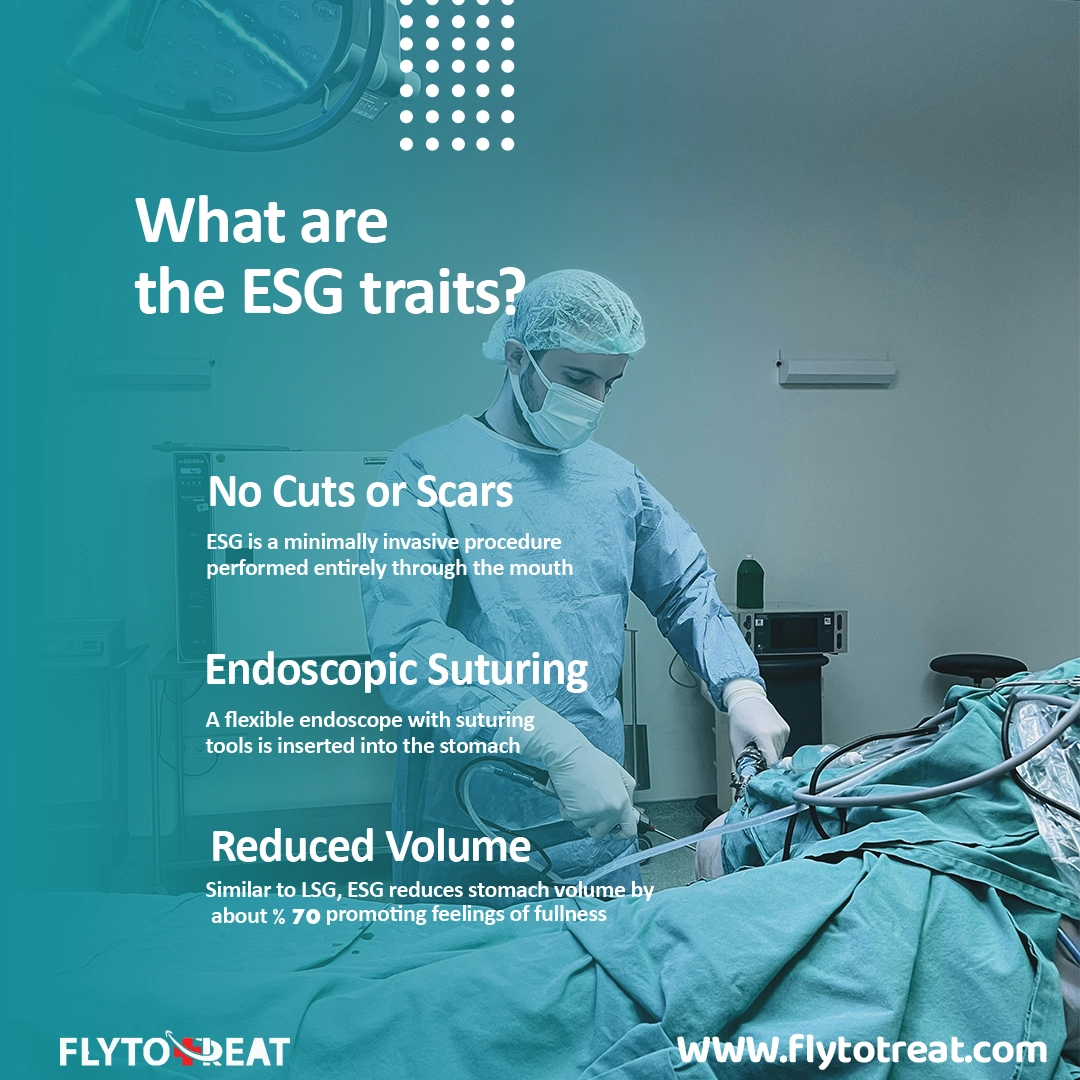
Is there a non-surgical gastric sleeve?
Endoscopic sleeve surgery is emerging as a promising alternative for those considering noninvasive bariatric procedures. At FlyToTreat, we recognize the importance of providing our patients with the latest advancements in weight loss surgery, including less invasive options that reduce recovery time and post-operative discomfort. This article will address critical questions such as "Is there a non-surgical gastric sleeve?" and "What is the most noninvasive bariatric surgery?" to help you make informed decisions about your health and surgical options.
What is a gastric sleeve?
The gastric sleeve, also known as sleeve gastrectomy, is a weight-loss surgery for people with severe obesity. It removes about 75-80% of the stomach to create a narrow sleeve-shaped pouch. This limits the amount of food that can be eaten at one time, reducing calorie intake and weight loss. Additionally, the surgery removes a section of the stomach that produces a hormone called ghrelin, which stimulates hunger. By eliminating this portion, the surgery may help regulate appetite. The procedure is typically minimally invasive, which means it is performed endoscopically or laparoscopically, leaving little or no incisions on the abdomen. This allows for faster recovery compared to traditional open surgeries.
What are the differences between Gastric sleeve vs gastric bypass
Both gastric sleeve and gastric bypass are practical weight-loss procedures but work differently. Here we compare these two method:
• Gastric Sleeve (Endoscopic or Laparoscopic Sleeve Gastrectomy):
• Focuses on Restriction: The stomach is reduced to a sleeve, limiting food intake.
• More straightforward Procedure: Generally less complex and shorter surgery time compared to bypass. The endoscopic sleeve surgery is the most noninvasive bariatric surgery.
• Preserves Digestion: Maintains the digestive system's natural anatomy.
• Gastric Bypass:
• Restriction and Malabsorption: A smaller stomach pouch is created, and the small intestine is rerouted, limiting food absorption.
• More Complex Surgery: Typically requires a longer surgery time than sleeve gastrectomy.
• Faster Weight Loss: This may lead to more rapid weight loss than sleeve surgery.
The best choice depends on weight loss goals, medical history, and anatomy. Talk to a doctor to determine which procedure is suitable for you.
Gastric sleeve side effects
Gastric sleeve surgery, while effective for weight loss, can come with some side effects. Medication, dietary adjustments, and lifestyle changes make most side effects manageable. Here's what to keep in mind:
• Short-Term:
• Pain and Discomfort: Soreness around the incision sites in the laparoscopic sleeve is joint after surgery. Pain medication can help manage this.
• Nausea and Vomiting: These are common in the initial recovery period and usually subside within a few days.
• Fatigue: Feeling tired after surgery is standard due to the body's healing process.
• Long-Term:
• Nutrient Deficiencies: Reduced stomach volume can limit nutrient absorption. Taking a daily multivitamin and following a balanced diet are crucial. Here, you can explore what a diet after gastric sleeve looks like.
• Dumping Syndrome: Rapid food movement from the pouch to the small intestine can cause nausea, sweating, and dizziness.
• Heartburn: While not everyone experiences it, some people may feel increased heartburn after surgery.
It would be best to get ready for gastric sleeve surgery to reduce its side effects
How much does gastric sleeve cost
Gastric sleeve surgery cost varies globally. Kidney transplant cost in Iran are as low as $3,800. In some countries like The USA, it ranges from $16,000 to $260,000. Costs differ significantly across countries and facilities, influenced by healthcare infrastructure and the quality of medical services. To help you understand the costs associated with gastric sleeve surgery, several factors must be considered. These include insurance coverage, the surgeon's expertise, additional expenses like prescriptions, follow-up checkups, and potential complications. It's important to verify what your health plan covers since coverage varies. Higher fees often correlate with high-level expertise, so the surgeon's skill and experience can also affect the cost. You may also want to consider noninvasive gastric sleeve surgeries in countries like Iran, which offer competitive prices without compromising quality. If you'd like to learn more about sleeve surgery costs, check out this article.
Gastric sleeve surgery requirements
Gastric sleeve surgery is a significant procedure to aid weight loss, but it's not for everyone. Here are the general requirements for considered noninvasive gastric sleeve surgery to be candidate:
• Body Mass Index (BMI):
• Typically, a BMI of 40 or higher is required.
• In some cases, a BMI of 35-39 with weight-related severe health problems might qualify.
• Weight Loss Attempts: Demonstrating documented attempts at weight loss through diet and exercise for a specific timeframe is usually required.
• Overall Health: You should be healthy without significant medical conditions that could make surgery high-risk.
• Psychological Evaluation: A psychological evaluation may be needed to assess your readiness and commitment to lifestyle changes post-surgery.
These are general guidelines and individual criteria may vary. Consult a bariatric surgeon or doctor to determine if you qualify for gastric sleeve surgery.
Gastric sleeve diet
The gastric sleeve diet begins about 2 weeks before surgery to ensure that the candidate does not confront any complications during the surgery.
After the surgery, you should follow some stages. Stages for non-invasive gastric sleeve surgery recovery:
1. Liquid diet - Water, broth, and sugar-free drinks.
2. Full liquids & pureed foods - Smoothies and mashed vegetables.
3. Soft foods - Scrambled eggs and cooked vegetables.
4. Regular diet - Balanced diet with high-protein and low-carb options, smaller portions.
Each stage promotes recovery and long-term success. Regular follow-ups with a dietitian are crucial to tailor the diet to your specific needs and to manage any potential issues like weight gain after VSG. Remember, the goal is to ensure a smooth transition back to health without compromising nutritional intake. For further insights, please check "diet after the gastric sleeve."
What are the benefits of a sleeve?
Gastric sleeve surgery, whether endoscopic sleeve surgery or laparoscopic sleeve gastrectomy (LSG), offers a range of advantages for people struggling with obesity:
• Significant Weight Loss: Studies show an average weight loss of 60-70% of excess body weight, promoting improved health and mobility.
• Reduced Hunger Hormones: as mentioned before, the portion of the stomach removed during surgery also produces ghrelin. This reduction can lead to feelings of fullness.
• Improved Health Outcomes: Weight loss can significantly improve or even resolve obesity-related conditions like type 2 diabetes, sleep apnea, and high blood pressure.
• Minimally Invasive: Laparoscopic sleeve surgery uses small incisions, leading to faster recovery times, less pain, and fewer scarring risks compared to traditional open surgery. Endoscopic sleeve surgery is even less invasive.
• Durable Results: Studies suggest that weight loss achieved through gastric sleeve surgery can be sustained long-term with proper dietary and lifestyle changes.
Noninvasive gastric sleeve
The traditional laparoscopic sleeve gastrectomy (LSG) might seem daunting for some seeking weight loss. However, a new option is the noninvasive gastric sleeve, also known as endoscopic sleeve gastroplasty (ESG).
• No Cuts or Scars: Unlike LSG, ESG is a minimally invasive procedure performed entirely through the mouth. No surgical incisions are required.
• Endoscopic Suturing: A flexible endoscope with suturing tools is inserted into the stomach. The surgeon uses these sutures to fold the stomach inward, creating a sleeve-like shape.
• Reduced Volume: Similar to LSG, ESG reduces stomach volume by about 70%, promoting feelings of fullness and aiding weight loss.

Types of gastric sleeve names
While "gastric sleeve" often refers to a specific procedure, there are variations within this category to consider:
• Vertical or Laparoscopic Sleeve Gastrectomy (VSG): This is the most common type of gastric sleeve surgery. It's a minimally invasive procedure where a portion of the stomach is removed laparoscopically (using small incisions) to create a sleeve shape.
• Endoscopic Sleeve Gastroplasty (ESG): This is a newer, noninvasive alternative to VSG. An endoscope (a thin, lighted tube) is inserted through the mouth to place sutures and reshape the stomach into a sleeve.
These are just the two main variations. Bariatric surgery is a complex field, and other techniques may exist. Always consult a doctor to determine the most suitable option for your weight loss goals and health profile.

conclusion
Endoscopic sleeve surgery significantly advances bariatric surgery, providing a noninvasive option for effective weight loss. FlyToTreat is dedicated to supporting patients through their journey with the latest surgical innovations. Whether you are exploring traditional laparoscopic sleeve gastrectomy or the noninvasive alternatives, it's essential to understand each procedure's implications fully. This article aims to equip you with the necessary information to confidently discuss potential options with your healthcare provider, ensuring the best outcomes for your health and well-being.
MEDICALLY REVIEWED BY: Dr. Ali Bazazi
AUTHOR: FlytoTreat's team of Authors
21 April 2024 - Updated At: 01 June 2024
Related Articles
Comment






